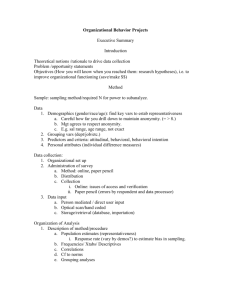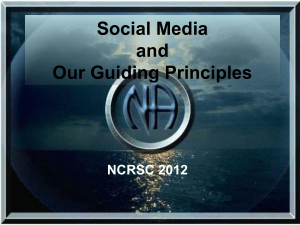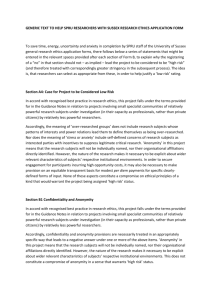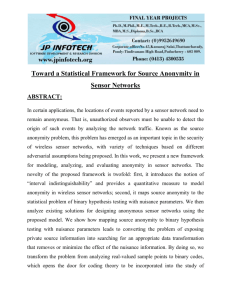Anonymous Feedback in E-Learning Systems
advertisement
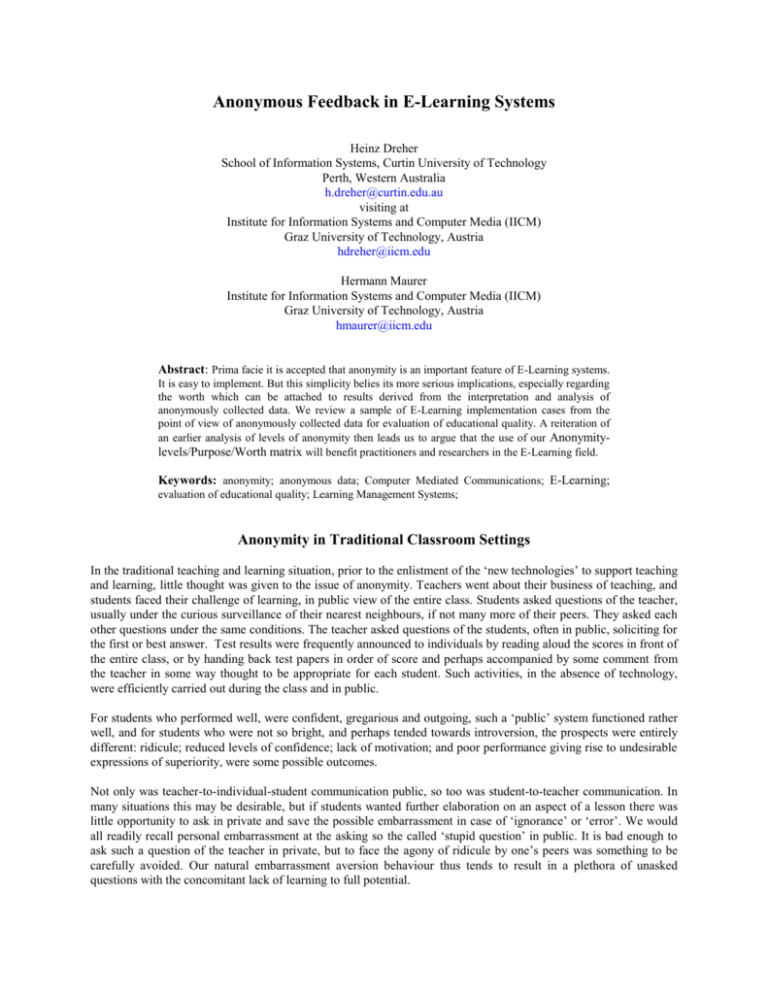
Anonymous Feedback in E-Learning Systems Heinz Dreher School of Information Systems, Curtin University of Technology Perth, Western Australia h.dreher@curtin.edu.au visiting at Institute for Information Systems and Computer Media (IICM) Graz University of Technology, Austria hdreher@iicm.edu Hermann Maurer Institute for Information Systems and Computer Media (IICM) Graz University of Technology, Austria hmaurer@iicm.edu Abstract: Prima facie it is accepted that anonymity is an important feature of E-Learning systems. It is easy to implement. But this simplicity belies its more serious implications, especially regarding the worth which can be attached to results derived from the interpretation and analysis of anonymously collected data. We review a sample of E-Learning implementation cases from the point of view of anonymously collected data for evaluation of educational quality. A reiteration of an earlier analysis of levels of anonymity then leads us to argue that the use of our Anonymitylevels/Purpose/Worth matrix will benefit practitioners and researchers in the E-Learning field. Keywords: anonymity; anonymous data; Computer Mediated Communications; E-Learning; evaluation of educational quality; Learning Management Systems; Anonymity in Traditional Classroom Settings In the traditional teaching and learning situation, prior to the enlistment of the ‘new technologies’ to support teaching and learning, little thought was given to the issue of anonymity. Teachers went about their business of teaching, and students faced their challenge of learning, in public view of the entire class. Students asked questions of the teacher, usually under the curious surveillance of their nearest neighbours, if not many more of their peers. They asked each other questions under the same conditions. The teacher asked questions of the students, often in public, soliciting for the first or best answer. Test results were frequently announced to individuals by reading aloud the scores in front of the entire class, or by handing back test papers in order of score and perhaps accompanied by some comment from the teacher in some way thought to be appropriate for each student. Such activities, in the absence of technology, were efficiently carried out during the class and in public. For students who performed well, were confident, gregarious and outgoing, such a ‘public’ system functioned rather well, and for students who were not so bright, and perhaps tended towards introversion, the prospects were entirely different: ridicule; reduced levels of confidence; lack of motivation; and poor performance giving rise to undesirable expressions of superiority, were some possible outcomes. Not only was teacher-to-individual-student communication public, so too was student-to-teacher communication. In many situations this may be desirable, but if students wanted further elaboration on an aspect of a lesson there was little opportunity to ask in private and save the possible embarrassment in case of ‘ignorance’ or ‘error’. We would all readily recall personal embarrassment at the asking so the called ‘stupid question’ in public. It is bad enough to ask such a question of the teacher in private, but to face the agony of ridicule by one’s peers was something to be carefully avoided. Our natural embarrassment aversion behaviour thus tends to result in a plethora of unasked questions with the concomitant lack of learning to full potential. Thoughtful teachers, those who realised that individual students varied in psychological disposition as well as in intellectual ability, and those who questioned the very methods which were accepted as good contemporary practice, were able to help their students realise their full potential by accommodating for individual differences, but these were in the minority. And it was hard work. The advent of technology brought with it the possibility of teaching larger numbers of students, even personalising the learning experience, and monitoring the effectiveness of the educational experience through the efficient collection of student opinion. We could safely conclude that respecting and preserving the anonymity of individual students was not achieved, or even attempted in the main, despite the negative consequences. The advent of technology, not simply computer and communications technology, but also the availability of cheap and immediate reproduction facilities such as photocopying, and all manner of other media (audio, 35mm slides, filmstrips, and later video) provided a major impetus to the emergence of a new branch of education known as “educational technology” in the 1970s and 1980s. Computer Mediated Communications Facilitates Anonymity Computer Mediated Communications (CMC) technology burst onto the world scene in the closing decade of last century, first in boardrooms frequented by rich company executives, but soon enough, as the power of personal computing spread and the Internet reached out to the world, the technology was within reach of universities and schools and finally private individuals working or studying from home. CMC technology made possible Learning Management Systems (LMS) and through them, the management of anonymity so as to promote learning and take cognisance of individual learner needs and abilities in interacting with teacher and peer alike. Of particular interest here in this article is the collection of student opinion of education quality in Learning Management Systems. Good teachers, whether using LMS or not, are very interested in monitoring the effectiveness of their own performance and that of the systems they enlist in the education enterprise, and through the use of CMC it is relatively simple and cost-efficient to collect such responses. We know that if a respondent is identifiable, the opinion submitted may not be as truthful as if that opinion was anonymously offered. This is precisely why democratic elections are conducted as secret ballots. In such elections the anonymity of the voter is safeguarded, but at the same time, controls exist to ensure that one and only one vote is counted for each elector (or some slight variation if voting is not compulsory). Looking at the education literature we found a selection of cases in which student opinion of educational quality was collected. Of interest are the cases where anonymity was safeguarded, but the matching controls to ensure one and only one input from an authoritative source were weak or absent. We observed that, despite such an absence of controls, the data was used to derive supposedly ‘valid’ and in any case, useful interpretations and conclusions about the quality of the education. This is surely a matter of concern and warrants further attention. Using CMC it is relatively simple to preserve the anonymity of contributors, however much more thought needs to go into a process of ‘secret ballot’-like controls to ensure the veracity of the data and thus the reliability and validity of the interpretations and conclusions drawn from such data. In this paper we argue that despite the desire or need to collect data, and the relative ease with which it can be collected via E-Learning systems, care must be taken as to the worth which is placed on data from anonymous sources. For the purpose of drawing attention to some possible problems, we conjecture that data collected from anonymous sources is of limited worth - worse still, it (data collected from anonymous sources) may be useless and lead to false expectations and unrealisable hopes on the part of respondents. Feedback is provided with an expectation that it is collected for a worthwhile purpose and the hope that the insight gained from its interpretation and analysis will make a difference, presumably for the better. It is important therefore that educational technology researchers arrange data gathering, analysis, and reporting so as to justify the implied trust of those participating in the research. Whilst it may be unrealistic to conduct our feedback on educational quality with the same rigor and controls of a democratic election, there are some guidelines which can be usefully be borne in mind. On the one hand we wish to promote participation and anonymity, and on the other we want to ensure the data can be relied upon in drawing some useful insights to improve the educational offering. The Importance of Anonymity Prima facie we all accept the notion of anonymity, but upon closer inspection we realise that a balance must be achieved between the preservation of the sources of research data and the value or worth we purport to adhere to the results derived from such data. In modern LMS it is perfectly straightforward to offer an online data collection device, ask students to use it, and at some time gather the results. The simplicity and ease with which this can be done may tend to lull us into a comfort zone from which we are not sensitive to the possible negative aspects of anonymous data. In her qualitative research study of seven mid-life adult learners studying an undergraduate program delivered online, Dianne Conrad (2002) observed that student public identification was an important aspect of learning. She found that a combination of three factors: online learners’ lack of anonymity; the societal inclination to be ‘nice’ people; and learners’ prolonged commitment to a program of learning; “created in them an increased sense of inhibition” (p12). This makes it clear that anonymity is not always a positive aspect. At the Lrnlab Course Website, Faculty of Education and Social Work, The University of Sydney, one finds a report by Paul Love (2003, p6) in which he states: “A further note that I would add to the benefits of online synchronous communication is that the concept of anonymity, … can help increase the students opportunity for participation. Discussions where students can log on as someone anonymous can enable them to risk ideas that they might feel uncomfortable raising in person”. This is the usual common positive effect attributed to anonymity, and is well understood by all people – perhaps one should say all people living in a democratic society. One student participating in an on-line computer science course at the Open University of Israel (Gal-Ezer and Lanzberg, 2003) said that the “partial anonymity” gave him the courage to ask questions and actively participate in the tutorial. We thus see degrees or levels of anonymity which may be usefully implemented by our Learning Management Systems. Of course, whatever we choose to implement, we need to have good control over access levels and anonymity. As Lennon and Maurer (2003, p1252) point out “In chat groups and forums, the system also provides levels of anonymity. This can be of considerable advantage when there are discrimination problems in the class”. The matter is not so simple as at first glance. In the recent report of the “DELPHI” project (Barajas, 2004, p13) the advice is that “pedagogues need special training for online-education. They must especially be qualified in knowing: • how to decrease anonymity and to establish the atmosphere of a learning community; • how to motivate and keep the motivation of learners high; • how to avoid student frustrations; • how to establish and maintain interaction among students, between teacher and students and between the user and the system; and • how to moderate discussions.” Levels of Anonymity In their 1995 paper, Flinn and Maurer, provide a comprehensive analysis of the anonymity issue as it pertains to networked computer systems – what we today may refer to as Computer Mediated Communications Systems, the facilities of which are present in all E-Learning systems. They propose six levels of anonymity numbered from 5 (Level 5 – Super-identification, the strongest and akin to a secret ballot) through to Level 0 at which there is no identification of the user (Table 1). Flinn and Maurer (1995, p45) present a scenario of the positive role of anonymity in an educational setting, “where the facility to have an anonymous electronic discussion removes the authoritarian role from the teacher or lecturer and enables the more diffident students to advance ideas without threat. Perhaps the most useful mode here is level 3. The teacher may wish to review or assess the degree and quality of statements and ideas expressed by participants, and in order to do this one needs access to the system records to link pseudonyms to actual student ids. One very useful aspect of being able to use multiple pseudonyms comes into play in this example; the teacher (or any other participant) is able to present several different viewpoints or sides of an argument using different pen-names. We feel that this is particularly valuable in an educational setting: it would appear a useful skill to be able to look at an argument, without being forced to be identified with or even to strongly hold a particular point of view. What is important is being able to marshal the appropriate facts to support or cast doubt on a particular hypothesis.” Wallace (1999) in her book The Psychology of the Internet, suggests a continuum of effects on our behaviour. The anonymity variable leads to disinhibition at one end of the continuum – “a lowering of the normal social constraints on behaviour. It is not an all or nothing variable, especially on the Internet, but we feel more or less anonymous in different Internet locales, and this affects the way we act.” (p.9). Whilst this may be more realistic than a six point scale such as suggested by Flinn and Maurer, the latter lends itself well to implementing in LMSs, and may provide a suitable level of granularity for most purposes. Table 1 – the six levels of ANONYMITY Level 5. Super-identification The user is authenticated and identified in a completely secure way – this implies zero anonymity. Level 4. Usual identification The user is known within the system by a user-name and password which must be provided prior to admission to the system. Level 3. Latent (potential) identification The user is known as person to the system and may develop and use a set of unique pseudonyms. Level 2. Pen-name identification The user is known within the system by some user-name and password, but there is no proper identification of the user as person. Level 1. Anonymous identification The user is identified by the system, but not as a specific individual and without pseudonym or pen-name, a user logs on anonymously (probably using a password), and the system keeps an event log. Level 0. No identification This is typical when using a stand-alone workstation; however it is possible for an application to log user activity, as in Level 1. The existence of a log permits profiling the (unknown) user, and can be used to gain information about user characteristics. True anonymity would require the absence of any personal history being associated with a user. Source: compiled from Flinn and Maurer (1995) The Role of Anonymous Data in Selected Studies In an early report of using the WWW to facilitate teaching, Rada (1996) used a standard university evaluation instrument for the anonymous rating teachers via the Web. Out of the total of 17 students, seven answered yielding an average score of 4.63 (on a 5 point scale with 5 meaning “excellent”) where the average of courses in that school was about 4. On that basis it was claimed that: “Overall, students were satisfied with the course” (p741). Any data may be better than no data, but with around 50% of data missing, it may be safer to claim that 50% of students were satisfied and some proportion of the other 50% may have been too. Apparently there were other factors in addition to “anonymity” which resulted in students not responding to the questionnaire. Note also that it is legitimate to ask about the controls which would ensure each student only responded once – this is not reported in the paper. In such a case, if we wanted to have results of high worth we would need to hold the ambiguity variable at much greater than the present Level 0 (presumably). In any event, reporting the anonymity level associated with the study would assist readers and researchers in making appropriate use of the study results. Schrum and Lamb (1996, p717) also posted an online evaluation survey near the end of their course in which “collaborative distance learning and training through electronic networks and groupware” technology was deployed to provide a learning environment for 18 students. Out of these, ten provided anonymous responses, on the basis of which the authors make appropriately cautious claims and balance this data with other feedback such as open-ended comments. This analysis and reporting seems to be more in the spirit of formative evaluation where the intent is incremental improvement as distinct from Rada’s summative evaluation mentioned above. In a second project Shrum and Lamb (1996, p727) alert the reader to the inherent difficulties associated with evaluation, even when rather elaborate and careful measures to get at the truth are implemented. They conclude that “Results suggest positive outcomes for content learning, and some strong suggestions for improving the structure and process of this type of online activity” (p728). They are unable to be more definitive, in this case because of a lack of anonymity - subjects felt they were being watched or identified, and controlled. In a course on teaching Hypertext and Hypermedia on the web, Paul De Bra (1996) notes that “The teacher cannot even deduce from the server log how many students are taking the course. Each student completing the assignment is a surprise to the teacher.” (p800). Imagine taking a traditional course and having all the students fully anonymous – nothing visible – no eyes, no hands, no shape, no voice-print, nothing! Teachers would surely not proceed under such circumstances, and yet we still claim that anonymity on E-Learning scenarios is desirable. De Bra seems to be clear about the worth of data collected from such a system, and perhaps that accounts for the absence of course evaluation based on student opinion – it would be of low worth. Finally, in a recent report of the use of a LMS in Austria (Dreher et al., 2003, p2597) the claim that the “results show a high acceptance of the system by students, especially for the purposes of submitting their contributions to the teacher, and for accessing the feedback from the teacher” can surely only be worthy of further serious attention if we know the anonymity conditions among other things (statistical representativeness, time of data collection, and so on). It is our contention that all these studies would have benefited from the inclusion of a thorough analysis, control, and reporting of anonymity conditions. Naturally, we cannot alter the past, but we can be guided by these insights into anonymity for the future, and it is in that spirit in which we offer our conclusion. Conclusion In a number of cases studied, we have noticed that a Level 0 anonymity is afforded the respondents and yet the results derived from the analysis of such data is confidently offered as support for the superior outcomes of the educational intervention or strategy. In other studies the researchers have been cautious and restrained in the claims they make based on anonymous input. We note that all researchers whose studies we have read have proceeded with their work in good faith, and our observations in this article are aimed at spreading the word of care and caution. In that spirit we suggest the use of Table 2 for making explicit the anonymity, purpose, and worth parameters of ELearning evaluations. The construction of a device such as the Anonymity-Purpose-Worth matrix (Table 2), in which the researchers match the purpose of their data collection with the desired or intended worth of their results, and assign an appropriate anonymity level, may illuminate this crucial aspect of collecting feedback in E-Learning systems and help clarify the legitimacy of conclusions being drawn from the analysis of such data. Table 2 – Anonymity-Purpose-Worth Matrix ANONYMITY level Level 5. Super-identification Purpose of data collection Worth of results why is the data being collected? of what value are the results intended to be? high value; high cost associated with failure or wrong decision making (can be costly to implement and cumbersome to use) provide specific accurate highly reliable data; e.g. leading to specifications for educational intervention affecting individuals; summative evaluation of performance Level 4. Usual identification summative evaluation of programmes and courses accurate and reliable advice but perhaps not comprehensive as respondents may be identified Level 3. Latent (potential) identification for decision making but acknowledging that further data collected at a higher level of anonymity may be needed potentially high, but depends on pseudonym control and respondent trust regarding confidentiality Level 2. Pen-name identification trend discovery indicative of trends; unsuited to underpin or justify change, e.g. where individuals may be affected Level 1. Anonymous identification informal evaluation; to highlight trends, and extremes indicative of the need for further investigation and may be used to justify such proposals Level 0. No identification formative evaluation data is sought indicative of intervention; probably not generalisable; suitable for informing microinterventions not directly affecting individuals note: the Purpose and Worth columns have been populated with indications of the particular entries designers and researchers may consider as they plan the appropriate anonymity levels to be applied to their E-Learning feedback systems. References Barajas, M. (2004). DELPHI: European Observatory of e-Learning Practice, Report on New Methods to Learning in Technology-based Environments, and Related Policy Matters: IST and IHP projects. EU FP6 Contract No: 2002-4075/001-001 EDU-ELEARN Conrad, D. (2002). Deep in the Hearts of Learners: Insights into the Nature of Online Community. Journal of Distance Education/Revue de l'enseignement à distance. Volume 17.1. De Bra, P.M.E. Teaching Hypertext and Hypermedia through the Web. Journal of Universal Computer Science, vol. 2, no. 12 (1996), 797-804 Dreher, H., Scerbakov, N., & Helic, D. (2004). Thematic Driven Learning. Proceedings of E-Learn 2004 Conference, pp25942600, AACE. Washington DC, USA, November 1-5, 2004. Flinn, B., and Maurer, H. (1995). Levels of Anonymity. Journal of Universal Computer Science, vol. 1, no. 1, 35-47. Gal-Ezer, J., and Lanzberg, D. (2003). Using synchronous and asynchronous online learning in computer science courses. Proceedings of the 33rd ASEE/IEEE Frontiers in Education Conference, session T3F1, November 5-8, Boulder, Colorado. Lennon, J. and Maurer, H. (2003). Why it is Difficult to Introduce e-Learning into Schools And Some New Solutions. Journal of Universal Computer Science, vol. 9, no. 10, 1244-1257 Love, P. (2003) Can a chat session accomplish and achieve the finer points of theoretical argument without having the face-toface stimulants and reactions that are readily apparent in a traditional classroom? Lrnlab Course Website, Faculty of Education and Social Work, The University of Sydney, http://lrnlab.edfac.usyd.edu.au/topics Rada, R. (1996). Teaching on the WWW: Assignment Focus and Information Indexing. Journal of Universal Computer Science, vol. 2, no. 10, 732-743 Wallace, P.M. (1999). The psychology of the Internet. Cambridge, UK: Cambridge University Press. Acknowledgements The authors are grateful for the editorial commentary and assistance provided by Naomi Dreher and Rainer Unland.

